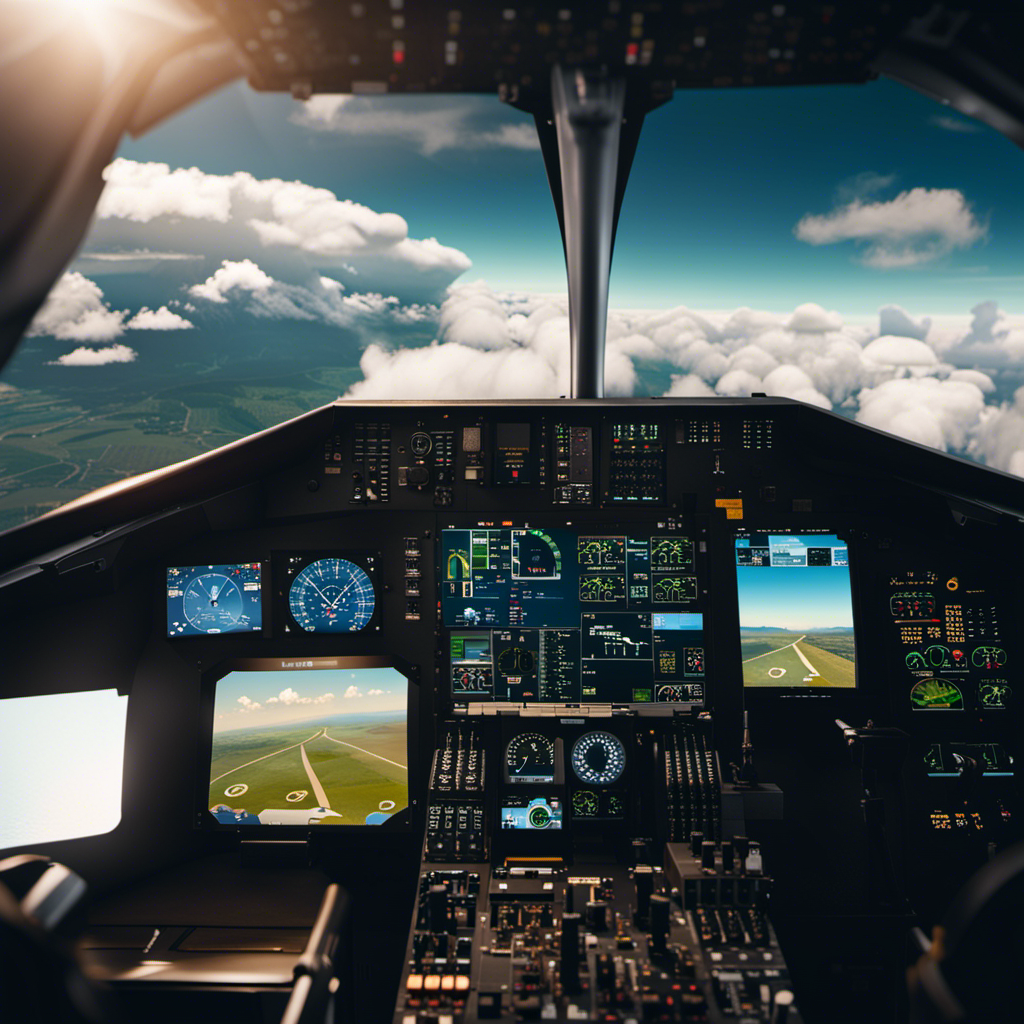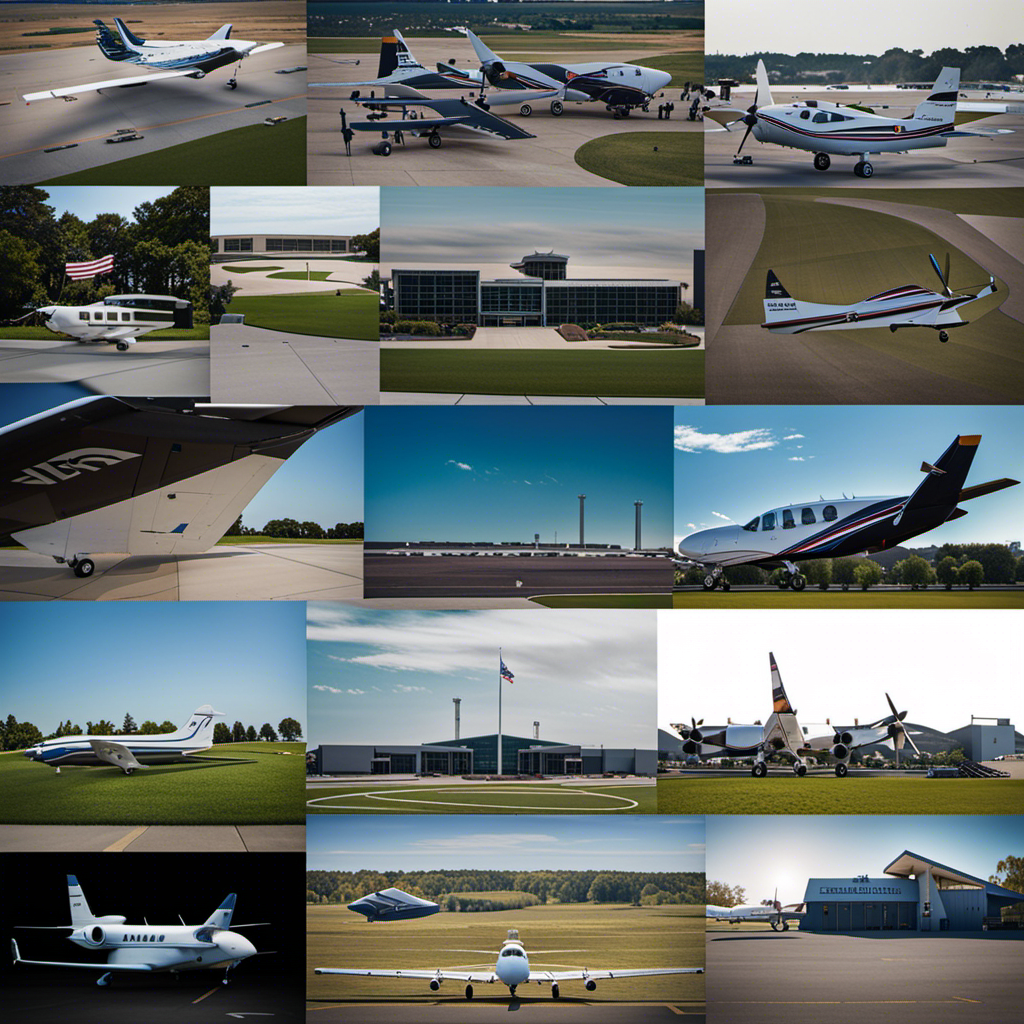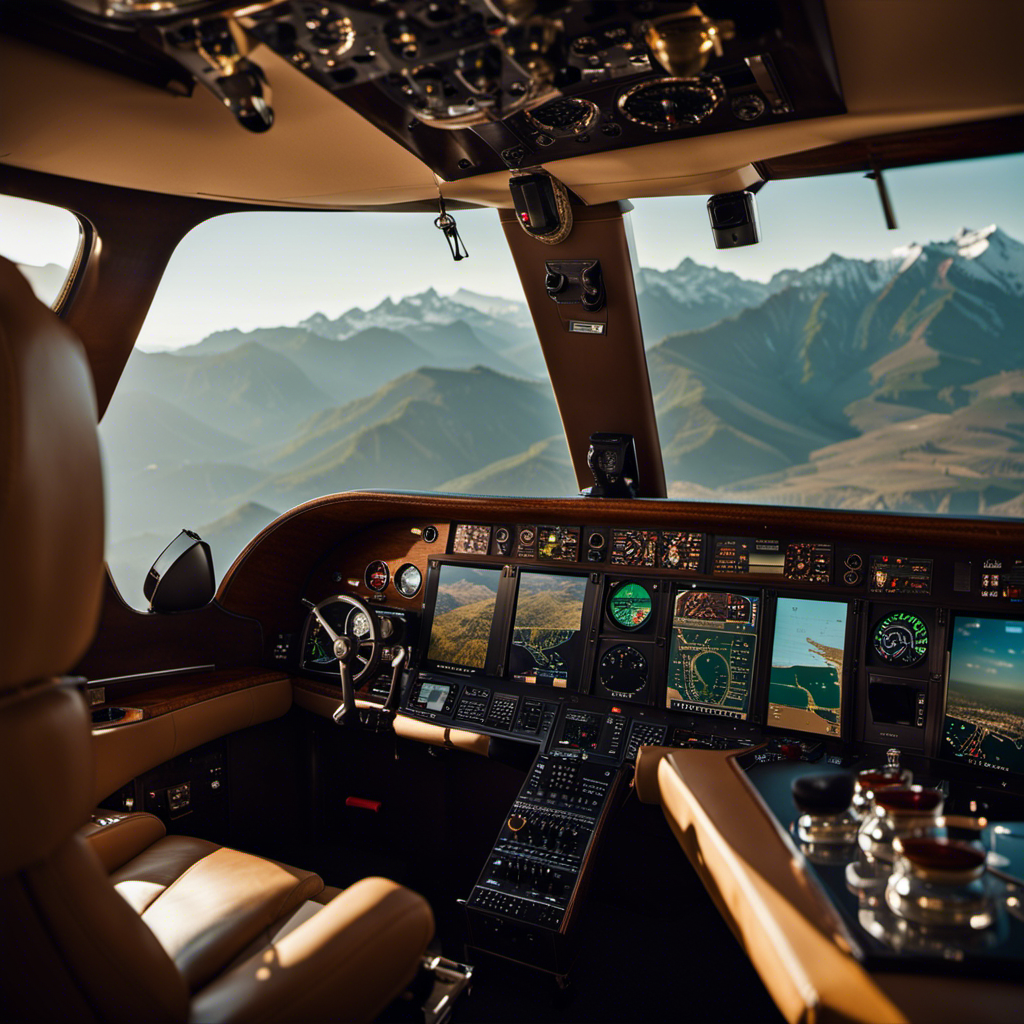I’ll always remember the initial experience of flying through the digital heavens, my fingers clenching an invisible steering control, with a rush of excitement pumping through my bloodstream.
Learning how to fly a plane online has opened up a whole new world of possibilities. With just a computer and an internet connection, I’ve been able to master the intricacies of flight controls, navigate complex aviation charts, and even perform daring aerobatic maneuvers.
Join me as we embark on an exhilarating journey, spreading our digital wings and discovering the thrill of flight from the comfort of our own homes.
Key Takeaways
- Mastering precise control and quick decision-making is essential for advanced maneuvers and emergency procedures.
- Aerobatics involves performing intricate maneuvers like loops, rolls, and spins.
- Emergency procedures focus on preparing pilots for unforeseen circumstances, including emergency landing techniques and controlled descents.
- Advanced maneuvers and emergency procedures require a combination of theoretical knowledge and practical training, with practical flight simulators providing a realistic and immersive experience for skill development.
The Benefits of Online Aviation Training
There are many benefits to online aviation training, such as flexibility and convenience.
Remote learning allows aspiring pilots to access training materials anytime and anywhere, eliminating the need to commute to a physical location. This flexibility is especially beneficial for individuals with busy schedules or those who live far from aviation training centers.
Online courses offer the convenience of learning at your own pace, allowing you to tailor your training to fit your specific needs. Whether you prefer to study during the day or at night, online aviation training provides the flexibility to accommodate your schedule.
With the ability to access course materials from your computer or mobile device, you can learn and practice aviation skills whenever and wherever it is most convenient for you.
Now, let’s move on to getting started: setting up your virtual cockpit.
Getting Started: Setting Up Your Virtual Cockpit
To begin setting up your virtual cockpit, you’ll need to familiarize yourself with the necessary software and hardware.
Virtual flight simulators are a key component of online flight schools, as they provide a realistic and immersive experience. These simulators allow you to practice flying in various weather conditions and aircraft types, all from the comfort of your own home.
You’ll need a computer or gaming console that meets the system requirements of the simulator software, as well as a joystick or flight yoke for controlling the aircraft. Additionally, some simulators may require additional peripherals like rudder pedals or head tracking devices for a more authentic experience.
Once you have the necessary equipment, you can dive into understanding the basics of flight controls and instruments, which will be discussed in the next section.
Understanding the Basics: Flight Controls and Instruments
Make sure you familiarize yourself with the basic flight controls and instruments in order to navigate the virtual cockpit effectively. Understanding the flight dynamics and aircraft systems is crucial for a successful flight simulation experience.
Here are the key elements to focus on:
-
Flight Controls: Get acquainted with the primary flight controls like the yoke or joystick, rudder pedals, and throttle. These allow you to control the pitch, roll, and yaw of the aircraft.
-
Instruments: Familiarize yourself with the essential instruments such as the attitude indicator, altimeter, airspeed indicator, and heading indicator. These provide crucial information about your aircraft’s position, altitude, speed, and heading.
-
Avionics: Explore the avionics systems like the radio stack, navigation equipment, and autopilot. Understanding how to use them will enhance your ability to navigate and communicate effectively.
-
Systems Management: Learn about the aircraft’s electrical, hydraulic, and fuel systems. Understanding these systems will help you troubleshoot any issues that may arise during your flight.
Navigating the Skies: Learning to Read Aviation Charts
Once you’ve familiarized yourself with the flight controls and instruments, navigating the skies becomes easier as you learn to read aviation charts.
Reading weather conditions and understanding airspace regulations are essential skills for any pilot. Aviation charts provide valuable information about weather patterns, terrain, and navigation aids. By studying these charts, you can determine the best routes to take, avoid restricted areas, and plan for potential weather hazards.
Weather symbols on the charts indicate cloud cover, precipitation, and visibility, allowing you to make informed decisions about when and where to fly. Additionally, airspace regulations are clearly depicted, ensuring that you stay within the designated areas and maintain safe distances from other aircraft.
Mastering the art of reading aviation charts is a crucial step towards becoming a skilled and confident pilot.
As you become proficient in reading aviation charts, you can then move on to mastering takeoff and landing techniques.
Mastering Takeoff and Landing Techniques
As you become more skilled, mastering takeoff and landing techniques will be crucial for your success as a pilot. Two important techniques to focus on are crosswind landings and short field takeoffs. Crosswind landings involve safely touching down in strong crosswinds, which can be challenging due to the effect it has on the aircraft’s control surfaces. On the other hand, short field takeoffs require precise planning and execution to get the aircraft off the ground in the shortest distance possible. To help you understand these techniques better, here’s a table summarizing the key points:
| Technique | Description |
|---|---|
| Crosswind Landings | Landing in strong crosswinds, requiring careful control of the aircraft’s attitude and control surfaces. |
| Short Field Takeoffs | Taking off in limited runway lengths, requiring precise planning and the use of flaps to generate more lift. |
Mastering these techniques will enhance your flying skills and make you a well-rounded pilot. Now, let’s move on to exploring different aircraft types and their features, where we can broaden our knowledge even further.
Exploring Different Aircraft Types and Their Features
When exploring different aircraft types and their features, you’ll discover a wide range of options to suit your flying preferences and needs. Here are some key factors to consider:
-
Size and Capacity:
-
Single-engine aircraft: Ideal for solo flying or small groups.
-
Multi-engine aircraft: Provides more power and capacity for longer flights.
-
Business jets: Designed for executives and offer luxurious interiors.
-
Performance and Range:
-
High-performance aircraft: Designed for speed and maneuverability.
-
Long-range aircraft: Equipped for extended flights without refueling.
-
Short takeoff and landing (STOL) aircraft: Suitable for remote and rugged areas.
-
Avionics and Technology:
-
Glass cockpit: Modern displays and navigation systems for enhanced situational awareness.
-
Autopilot systems: Assist with navigation and flight control.
-
Aircraft maintenance: Ensure compliance with aviation regulations to maintain safety and reliability.
Understanding these features will help you make an informed decision when selecting an aircraft. Now, let’s move on to advanced maneuvers such as aerobatics and emergency procedures.
Advanced Maneuvers: Aerobatics and Emergency Procedures
To perform advanced maneuvers like aerobatics and emergency procedures, you’ll need to master precise control and quick decision-making.
Aerobatics is a thrilling aspect of flying, often showcased in aerobatic competitions. It involves performing intricate maneuvers such as loops, rolls, and spins, pushing the limits of both pilot and aircraft.
Emergency procedures, on the other hand, focus on preparing pilots for unforeseen circumstances. This includes learning emergency landing techniques, such as selecting suitable landing sites and executing controlled descents in case of engine failure or other emergencies.
These skills require a combination of theoretical knowledge and practical training. By understanding the principles behind these maneuvers and practicing them diligently, pilots can enhance their flying abilities and be better prepared to handle challenging situations.
Now, let’s explore how practical flight simulations put your skills to the test.
Practical Flight Simulations: Putting Your Skills to the Test
After mastering the art of advanced maneuvers and emergency procedures, it’s time to put your piloting skills to the ultimate test with practical flight simulators. These innovative tools allow aspiring aviators to undergo flight training at home, providing a realistic and immersive experience that closely mirrors being inside an actual cockpit.
Practical flight simulators offer a range of aircraft models, terrains, and weather conditions, enabling you to practice takeoffs, landings, and in-flight procedures in various scenarios. With detailed controls and accurate physics, you can fine-tune your skills and develop muscle memory, all from the comfort of your own home.
By utilizing these simulators, you can gain valuable experience, build confidence, and refine your techniques before taking to the skies for real. So, let’s dive into the world of practical flight simulators and discover how they can enhance your flight training journey.
And now, let’s explore the next crucial aspect of flight training: progress tracking and feedback, where you can monitor your improvement and receive valuable guidance along the way.
Progress Tracking and Feedback: Monitoring Your Improvement
As you navigate through your flight training journey, progress tracking and feedback become essential tools for monitoring your improvement and receiving valuable guidance.
With the advancement of technology, online flight training platforms offer features that allow you to track your progress in real-time. These platforms provide personalized coaching, which helps you identify areas that need improvement and develop a customized training plan.
Progress tracking enables you to see your strengths and weaknesses, allowing you to focus on specific areas for growth. Additionally, receiving feedback from experienced instructors is crucial for your development as a pilot.
Their expertise and guidance help refine your skills and ensure you are on the right path. By utilizing progress tracking and personalized coaching, you can take your skills to the real world and seamlessly transition to physical flight training, putting your online learning into practice.
Taking Your Skills to the Real World: Transitioning to Physical Flight Training
When transitioning to physical flight training, you’ll find that the skills you’ve honed online seamlessly translate into real-world practice. The online training provides a solid foundation, but there’s nothing quite like the feeling of sitting in the cockpit and taking control of an actual aircraft. However, the real world challenges can be intimidating, especially for those who have never flown before. Overcoming fear is a crucial step in this process. It’s important to remember that every pilot has faced these challenges, and with proper guidance and practice, you can conquer them too. Here is a table that highlights some common challenges and ways to overcome them:
| Real World Challenges | Overcoming Fear |
|---|---|
| First solo flight | Trust in your training |
| Navigation | Practice and preparation |
| Weather conditions | Seek guidance from experienced pilots |
| Emergency situations | Stay calm and follow procedures |
| Landing | Focus on technique and follow instructions |
Frequently Asked Questions
Are there any age restrictions or prerequisites for enrolling in online aviation training?
There are age restrictions and prerequisites for enrolling in online aviation training. The specific age requirements and prerequisites vary depending on the program, but they are typically outlined by the training provider.
Are there any limitations to the types of aircraft that can be simulated in online aviation training?
In online aviation training, there are limitations to the types of aircraft that can be simulated. While it may not include all models, the training provides real-world applications to gain essential skills and knowledge.
How do online aviation training programs provide practical flight simulations?
Online aviation training programs provide practical flight simulations through remote flight training. These simulations allow pilots to experience the various aspects of flying a plane, including takeoff, landing, and navigation, all from the comfort of their own location.
Is there any certification or accreditation associated with completing online aviation training?
Yes, there is certification and accreditation associated with completing online aviation training. These credentials are proof of the successful completion of the program, ensuring that the training meets industry standards and requirements.
How does online aviation training compare to traditional physical flight training in terms of cost?
Online aviation training typically costs less than traditional physical flight training due to factors such as reduced overhead costs. However, the effectiveness of online training can vary depending on individual learning styles and the level of hands-on experience provided.
Conclusion
In conclusion, online aviation training offers a multitude of benefits for aspiring pilots.
From the convenience of setting up a virtual cockpit to mastering flight controls and instruments, the comprehensive nature of these courses allows for a thorough understanding of aviation principles.
While some may argue that virtual simulations cannot fully replicate the experience of physical flight training, it is important to note that the practical flight simulations and progress tracking offered online serve as valuable tools to enhance skills before transitioning to real-world training.
So, why wait? Start your aviation journey online and let your dreams take flight!
With a heart that soars as high as the skies, Aria, affectionately known as “Skylark,” is the driving force behind Soaring Skyways. Her journey into the gliding world began as a young dreamer gazing up at the soaring birds, yearning to experience the weightlessness and freedom they embodied. With years of experience both in the cockpit and behind the scenes, Aria’s commitment to the gliding community is unwavering.










